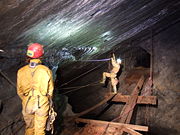
Croesor Quarry
Encyclopedia


Slate industry
The slate industry is the industry related to the extraction and processing of slate. Slate is either quarried from a slate quarry or reached by tunneling in a slate mine. Common uses for slate include as a roofing material, a flooring material, gravestones and memorial tablets, and for electrical...
in north Wales
Wales
Wales is a country that is part of the United Kingdom and the island of Great Britain, bordered by England to its east and the Atlantic Ocean and Irish Sea to its west. It has a population of three million, and a total area of 20,779 km²...
which was served by Croesor Tramway
Croesor Tramway
The Croesor Tramway was a Welsh narrow gauge railway line built to carry slate from the Croesor slate mines to Porthmadog. It was built in 1864 without an Act of Parliament and was operated using horse power....
. It has a single adit in the hillside and ceased operation after a hundred years in 1930 having produced 11,000 tonnes of finished slate annually at its peak.
Features
Croesor Quarry is notable amongst Welsh slate quarries for being almost entirely underground, with no significant surface workings. It was rare in its extensive use of forced air ventilation instead of the more common natural ventilation used in most slate mines. It also generated relatively small external waste tips compared with the volume of finished slates produced; this was largely achieved by back-filling underground chambers with waste once they were exhausted.History
Croesor Quarry was initially worked from 1846 until 1878. From 1864 onwards, the quarry was connected to the slate wharves at PorthmadogPorthmadog
Porthmadog , known locally as "Port", and historically rendered into English as Portmadoc, is a small coastal town and community in the Eifionydd area of Gwynedd, in Wales. Prior to the Local Government Act 1972 it was in the administrative county of Caernarfonshire. The town lies east of...
by an incline to the head of the Croesor Tramway. After a hiatus, it re-opened in 1895 and continued in production until 1930.
In the 1960s the quarry was operated by Cookes Explosive, a local firm who used its underground chambers to store explosives. In the early 1970s it was purchased by the Ffestiniog Slate Company with a view to reopening it as a working slate quarry. Planning permission for this was not granted and in the later 1970s most of the remaining mine infrastructure was removed for use in the Oakeley Quarry
Oakeley Quarry
Oakeley Quarry is a slate mine in the town of Blaenau Ffestiniog, north Wales.- History :Oakeley Quarry originated in 1818 when Samuel Holland leased a small quarry at Rhiwbryfdir farm. This venture was successful and was sold in 1825 to the Welsh Slate Company. Holland then opened a new quarry at...
, also owned by the Ffestiniog Slate Company.
Current conditions
The whole mine is largely shattered and not in particularly good condition. Chamber 1 East was possibly the biggest underground chamber in the slate industry, being several colossal chambers worked into one void – so big in fact the roof couldn’t support itself any longer and it collapsed. The top third of the chamber remains intact.Croesor Quarry is connected to the nearby Rhosydd Quarry
Rhosydd Quarry
Rhosydd Quarry is a slate mine located north east of Porthmadog in north Wales.- History :The earliest workings recorded at Rhosydd date back to the 1830s when small hilltop excavations were made. By the 1850s quarrying had moved underground...
by a tunnel that was built to aid surveying and settle boundary disputes.
In spite of a series of collapses, the Croesor to Rhosydd through trip is still possible and has long been considered a classic trip for mine explorers. Fixed ropes, home-made suspension bridges, zip wires, and inflatable boats have been installed which make it possible to complete the journey in comfort although not necessarily in safety.
Mine Status as of July 2010
Several of the fixed ropes have been replaced; however the first pitch rope is worn to the core a few meters from the bottom. Using your own ropes for a pull-through is recommended. The zip line is in good condition with a new safety rope along side it. The suspension bridge no longer exists (and hasn't for around 18 months) so a boat normally has to be used for this crossing. The various bridge crossings have also had new ropes and the status of the steel cables remains good. The final bridge before the long boat crossing now only has a single rail for the first section; however this has now been secured in the middle by rope. The boat pull-cord is in good condition and works well. Many of the old damaged boats have been removed and there are a couple of good ones (but take your own anyway). Rhosydd mine is still in good condition
Mine Status as of March 22nd 2011
The suspension bridge has been repaired and was still in place on the date above.
There is a rigid hulled open canoe in the final lake that can hold up to 3 people. The pulley system is still working well.

